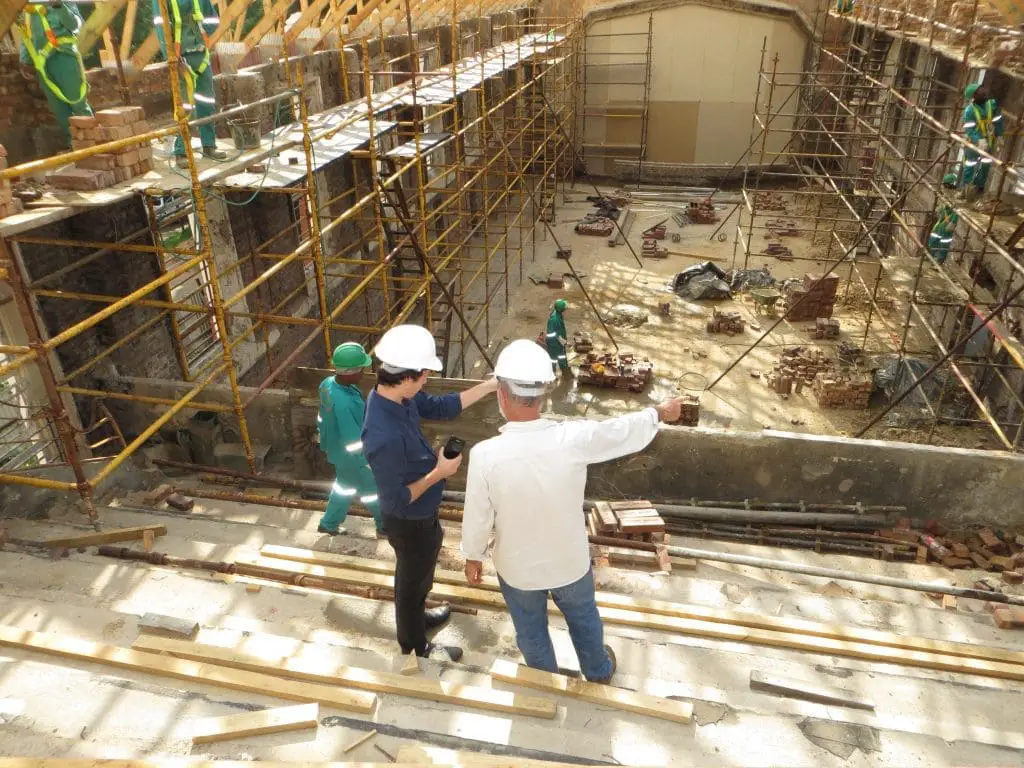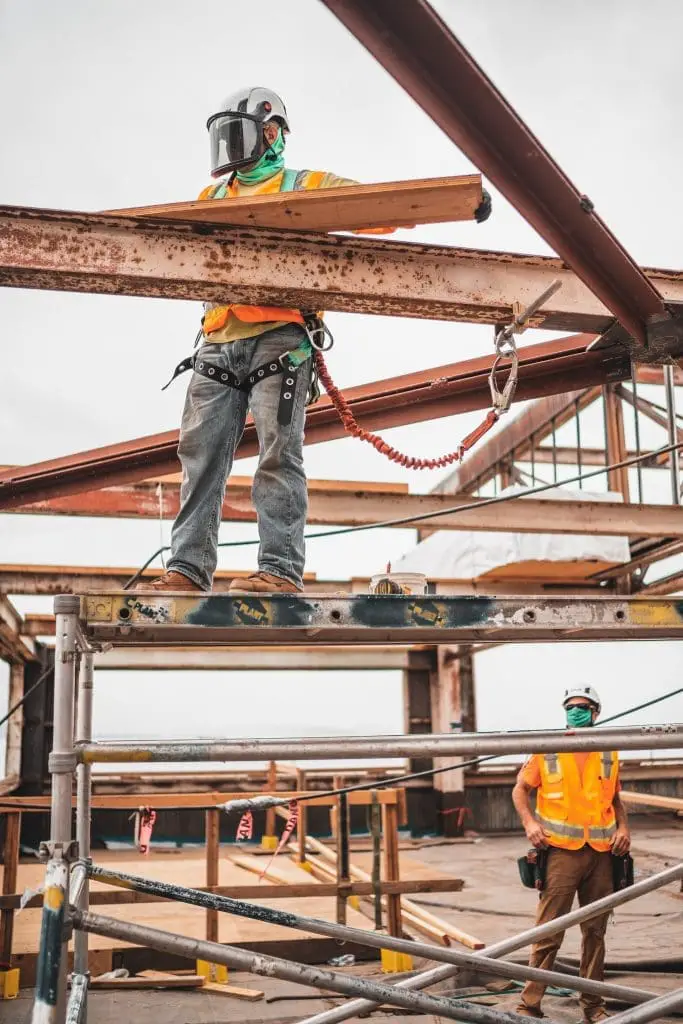It’s never been safer to work in the construction industry, but that doesn’t mean that the risk of injury and illness in the sector isn’t still prominent. The domestic construction industry still sees tens of thousands of injuries and illnesses recorded every year. Between 2018 and 2021, the sector averaged 74,000 work-related illnesses and 61,000 non-fatal injuries a year, with 39 fatalities in 2020-2021 alone.
Those numbers demand ongoing attention from regulatory bodies and employers alike. But with the latter taking on much of the responsibility for day-to-day safety in the industry, what can construction businesses be doing to ensure good core safety practices on site? Even companies that arrive on site like construction equipment shipping companies such as www.a1autotransport.com/shipping-construction-equipment/ need to comply with high safety standards.
Improve your PPE
PPE may have found a strange form of celebrity through the COVID-19 pandemic, but it has been the foundational building block of modern health and safety in construction since the introduction of the Personal Protective Equipment Regulations in 1992.
As a business owner, it’s essential to provide your employees with the appropriate PPE for the job. Typical construction projects demand the likes of helmets, hi-vis clothing, knee pads, and ear and eye protection. Furthermore, on-site PPE should be of the highest quality and well maintained – being replaced as soon as it’s no longer fit for purpose.
Invest in health and safety training
An investment in health and safety training is an investment in the business itself. According to an analysis by Herts Tools Co, injuries and ill health are costing the UK construction industry upwards of £16.2 billion a year.
If you don’t want to pay more into that pot than you have to, health and safety training should be another fundamental alongside your PPE. Training staff to understand the risks of the job, instilling sound on-site practices, and teaching the proper use of equipment will all pay dividends from both an ethical and financial standpoint.

Regular Equipment Maintenance
The construction industry is one of the most dangerous sectors to work in due to the hazardous nature of the work involved. Workers on construction sites are exposed to various risks, such as falls, electrocution, and equipment accidents.
Ensuring that all machines on a construction site are in good working condition is crucial. Regular equipment maintenance using high-quality bobcat aftermarket replacement parts can help prevent breakdowns and reduce the risk of accidents. By keeping machines in good condition, workers can operate them more safely.
Install a “Safety Concern hazardous” Box
You could create a confidential safety box where employees can anonymously submit any concerns about the job site hazards. This allows employers to stay informed about any hazardous conditions, or faulty equipment. Meaning they can address these situations immediately. Being anonymous means employees feel safe when they express their concerns without fear of being reprimanded.
Get construction insurance
With everyday safety concerns to take into account in the construction industry, the importance of comprehensive construction insurance has never been higher. Having something in place which can potentially protect your business will ensure your staff can enter every new project with the knowledge that they have a much-needed safety net in place.
Of the aforementioned £16.2bn costs of injury and ill health in the construction sector this past year, employers are estimated to have shouldered around 20% (£3.16bn) of the burden. Perhaps more shocking is that the injured and ill individuals themselves suffer the brunt (59%, or £9.56bn) of the costs.
Statistics like these press the importance of proper health and safety even further home for construction businesses. Employers may utilise health and safety practices to protect their profit margins and productivity first, but the duty of care they owe to their employees stretches well beyond the initial trauma of an injury or illness suffered on-site.
With the physical, mental and financial toll of construction-based injuries and illnesses a potentially heavy one on your employees, ensuring good health and safety practices should be the cornerstone of your everyday operations. Also, hire the best Structural Engineers Cumbria who have working skills that keep your workers safe in the construction site.
Common Construction Site Hazards And How To Work Safely
Since we’ve already gone over some of the most common measures to help make sure that construction workers stay safe while taking on project, let’s take a look at some of the most common hazards of being in the construction industry and how you can deal with them.
Many hazards come with working in construction. Any reputable construction company will take extensive measures to ensure the safety of its staff.
One of the best methods of prevention is education, so it is crucial to understand the different risks posed by construction work and how every individual has a role to play in keeping everyone safe. Read on for some of the most common hazards and how you can work safely with them.
1. Falls, Slips And Trips
The most common cause of workplace injuries are falls, slips and trips. When working in construction, these risks can be even more significant. You can reduce the chances of falls, trips and slips by ensuring that the site is always clear and tidy, well-lit and that adequate footwear is provided to all workers.
2. Electricity
Electrocution can potentially be fatal and can cause falls and other injuries. Therefore, any electrical work must be carried out by qualified electricians. You should also ensure that the site has been adequately surveyed to identify any potentially hazardous electrical cables on site.
3. Loud Noises
Working in construction can put workers into contact with a range of equipment that can produce loud noises. Exposure to loud noises over time can result in hearing damage or conditions like tinnitus. Therefore, it is essential to provide all workers with appropriate ear protection if they work with loud equipment. It would be best if you also had site guidelines for communication when wearing ear defenders.
4. Working At Height
Working at height can pose a wide range of potential risks, the most common being falls. It is crucial to invest in high-quality Height Safety PPE if your workers will be working at height. Safe At Heights is an industry leader in providing safety equipment for working at height and can provide PPE for a broad range of height work needs.
5. Chemicals
You should ensure that any chemicals on site are handled with appropriate care and attention. Chemicals should be kept in suitable containers and away from electricity or open flames. You should ensure that you take all reasonable steps when bringing chemicals on-site and that all workers understand the best way to handle them. If you are working with abrasives, make sure to wear a blast suit and other protective gear to avoid accidents.
Investing in proper hazardous material storage is one of the best ways to keep workers safe in the construction industry. It reduces the chance of fires and chemical spills which can be very dangerous to workers.
6. Fire
Fire is one of the deadliest hazards that can be found in construction sites. You should ensure that there is a clear fire safety policy in place that lists the steps to be taken in the event of a fire. You should have sign-in sheets to ensure that someone knows who is on-site at any given time and have fire extinguishers throughout the site.
7. Struck By An Object
Being struck by an object on site is another common hazard. You can prevent the risks of being struck and injured by wearing appropriate PPE like hard hats and safety goggles. It is also important to keep tools and equipment properly secured and avoid working directly below someone working with tools from height. You should also ensure that any vehicles are driven with complete visibility, particularly when in reverse.
Tips To Ensure Your Construction Team Stays Motivated And Productive
Aside from making sure that members of your construction team stay safe while they’re working, you also need to make sure that they stay motivated.
Many construction project managers recognize the importance of meeting deadlines and optimizing their projects, but not as many focus on keeping their teams motivated and productive. Staff productivity plays a huge role in delivering successful projects and increasing profitability. Therefore, it’s important to ensure that your employees feel happy and proud of their work as this will encourage them to continue striving for great results. This will also help you retain industry talent instead of having to hire new employees, which can cause delays and loss of money. Below you will find a few practical tips to help you motivate your construction team and increase their productivity.
1. Establish Clear Goals
Lack of clear goals and expectations means that your employees may end up feeling demotivated or unsure of what is required of them. Consequently, it’s essential to let them know what tasks they are expected to perform and what results you are looking for at the end of each project. You should also set deadlines so that everyone on your team is aware of the schedule in place. Once everyone understands their role and the overall goals of the company, they can focus on working hard to complete their assignments. In turn, this will help you improve time management and boost productivity.
If your company’s goals and expectations are unclear, your employees may become unmotivated or uncertain of what is expected of them. Therefore, it’s crucial to let them know what duties they have to fulfill and the outcomes you are seeking for at the conclusion of each job. Construction project management software makes it simple to set deadlines, distribute jobs, and monitor progress. You should also establish deadlines so that everyone on your team is aware of the established schedule. Once everyone is aware of their jobs and the overall goals of the organization, they can focus on working diligently to complete their tasks. In this way, you may ensure both increased productivity and effective time management
2. Provide Effective Communication
Encouraging open communication between your employees will play a key role in increasing motivation and productivity. Moreover, engaging with your team on a regular basis will ensure they don’t feel isolated from management. To facilitate communication, you can use construction project management software, such as Kahua, who offer a modern cloud-based solution, that will change the way projects are managed. This helpful management software for construction is designed to optimize commercial construction projects, enabling everyone to operate at peak performance. Utilizing project management software in construction will provide you with visibility into issues you might not have noticed, enabling you to quickly implement effective solutions.

3. Create A Comfortable Working Atmosphere
If your employees are constantly working in a stressful and tense environment, it’s unlikely that they will deliver successful projects. This is because workplace stress can often lead to feelings of frustration and demotivation. Therefore, you should strive to create a comfortable and relaxing working environment, which will allow your employees to thrive every day. Ensure that your employees know that you care about their health and wellbeing. Show them they are part of a team and offer to help them with any problems they might be facing at the moment.
4. Ask For Their Input
It’s also important to make sure that employees know that their input is appreciated. This means that they will be able to see the bigger picture and the impact that their contributions have had on the company. As a result, they will feel valued, which will motivate them to continue working hard and sharing their opinions and ideas. Whether you are dealing with a complex project or you are working on a small task, you should always ask employees to express their thoughts to the rest of the team. Also, remember to take their suggestions into account to show them that you are responsive to their needs.
5. Reward Your Team
Remember to celebrate your team’s achievements, no matter how big or small they are. Moreover, rewarding them at the end of a hard day goes a long way in construction. For example, if your team has spent the whole day in the blazing heat, be sure to treat them to a nice meal. Others might also need a cup of coffee to help them stay alert throughout the day. It might also be a good idea to take your team out on a regular basis and get to know them better. Also, when a job has been completed to a high standard, remember to compliment your staff.
6. Encourage Development And Growth
Another crucial component of motivating your employees is encouraging them to develop their skills and grow. This means that you should allow each individual to explore their capabilities and determine what they would like to achieve in the future. To ensure that everyone can progress, you should provide your team with more challenging tasks that will put them outside of their comfort zone. If employees often feel bored, they are unlikely to put any effort into their jobs. Additionally, make sure you advertise any career advancement opportunities internally to show your loyalty to the staff.
7. Set A Good Example
While you are focused on helping your employees improve, remember that they are also paying attention to your actions and behavior. Therefore, you should develop employee-centered leadership, which will provide you with a variety of benefits. Show your employees that they can count on you when problems arise. Always maintain a positive attitude, which your team will likely admire and follow. Also, even when difficulties arise, you should stay calm and patient to minimize stress.




